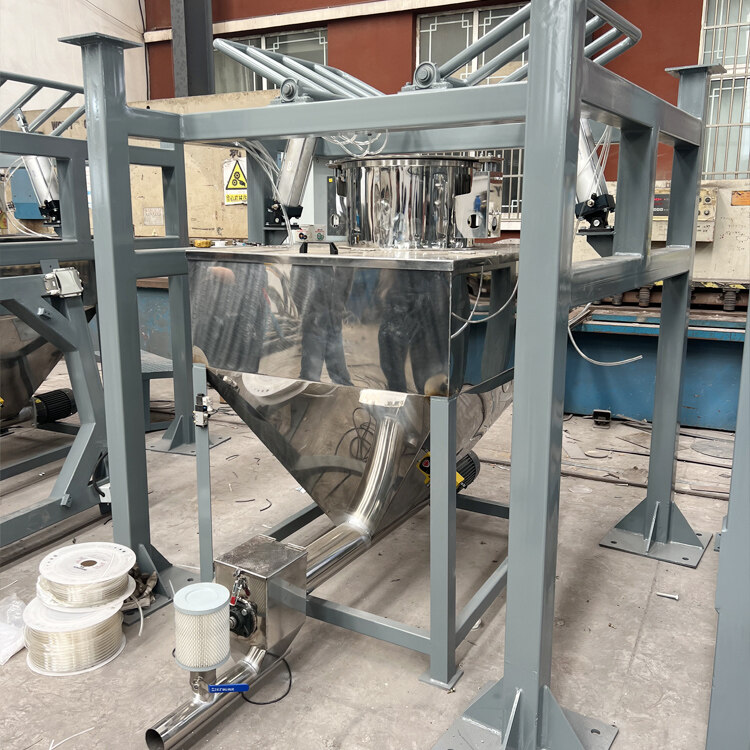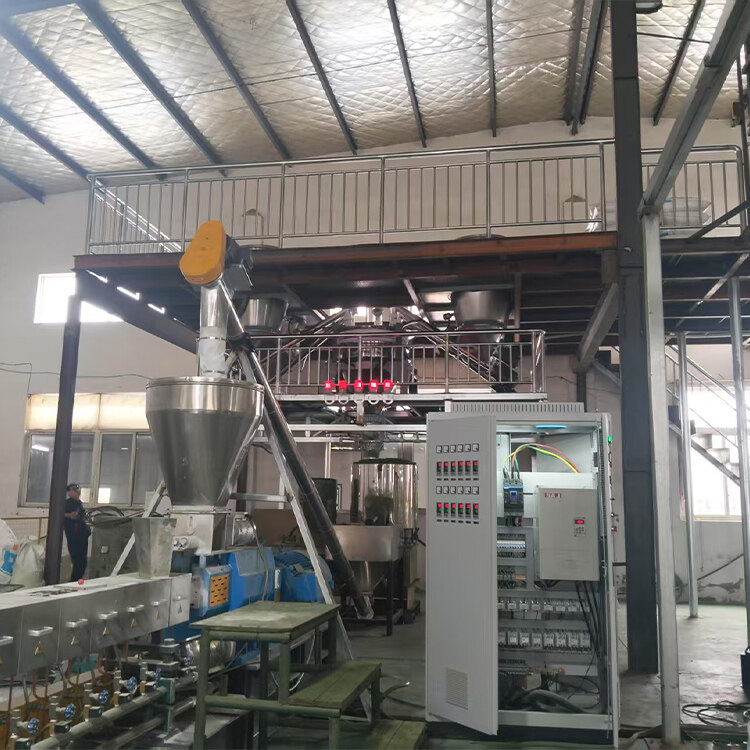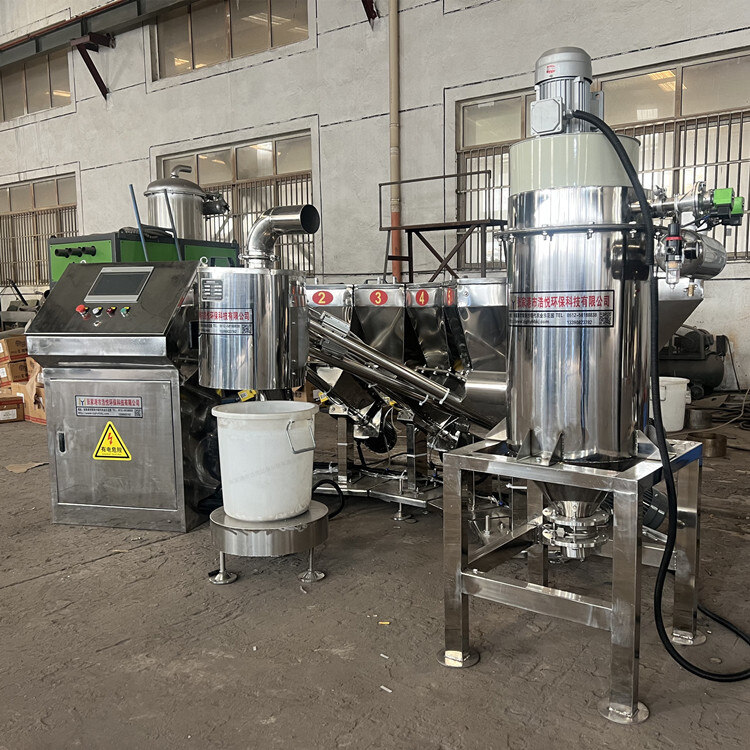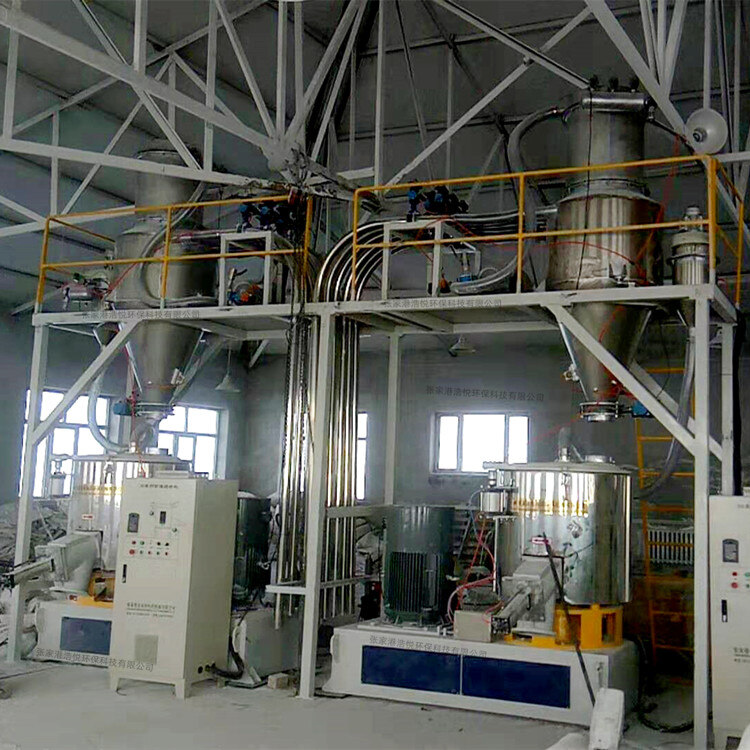- Introduction to automatic batching machine and fully automatic batching machine equipment
- The powder metering system tells you about the introduction of the mixing and drying machine
- 1000kg vacuum feeding machine
- Fully automatic small material batching system
- Research on Innovation of Automatic Weighing Machine Technology
- Design and operation of automatic batching system using PLC, industrial computer and frequency converter
Spiral powder feeding machine
- Category:Spiral Feeder
- Hits:128次
- Release Date:2025-06-30
- Share:
- Inquiry
- Details
In many industries such as chemical, food, building materials, and pharmaceuticals, efficient and stable transportation of powdered materials is a key link in ensuring production continuity and product quality. As a specialized conveying equipment designed for powdered materials, the spiral powder feeder has become an important choice for enterprises to achieve automated material transportation due to its compact structure, high conveying efficiency, and good sealing. It transports powdered materials from one place to another through the rotation of spiral blades, and is widely used in production processes such as raw material transportation and ingredient addition. The following will provide a comprehensive and in-depth introduction to the spiral powder feeder from the aspects of equipment structure, working principle, core advantages, application scenarios, and development trends.
1、 Core structure composition of equipment
The spiral powder feeding machine is mainly composed of six core components: the driving device, the spiral shaft, the feeding groove, the feeding port, the discharging port, and the control system. Each part cooperates with each other to form a complete material conveying system.
(1) Drive device
The driving device is the power source of the spiral powder feeder, mainly composed of a motor, a reducer, and a coupling. Motors are usually selected as three-phase asynchronous motors, and the appropriate power and speed are chosen based on the conveying capacity and operating requirements of the feeding machine. Reducer is used to reduce the speed of the motor and increase the torque, so that the screw shaft can operate at an appropriate speed. Common types of reducers include cycloidal pinwheel reducers, gear reducers, etc. Couplings are used to connect the output shaft of the motor and the input shaft of the gearbox, ensuring smooth power transmission while also having a certain buffering and shock-absorbing effect, reducing vibration and noise during equipment operation.
(2) Spiral shaft
The spiral shaft is the core component of the spiral powder feeder, consisting of a shaft body and spiral blades. The shaft body is generally made of high-strength alloy steel, which has sufficient strength and rigidity to withstand the torque and pressure during material transportation. Spiral blades are welded or riveted onto the shaft body. According to the material characteristics and conveying requirements, spiral blades can be divided into three forms: solid spiral surface, belt spiral surface, and blade spiral surface. Solid spiral surface is suitable for conveying powdery materials with good fluidity; Belt spiral surface is suitable for conveying materials with high viscosity or easy agglomeration; The blade helical surface is suitable for conveying materials with high specific gravity and strong wear resistance. The pitch and diameter of the spiral blades will also be optimized according to the characteristics of the material and the conveying capacity to ensure smooth conveying of the material.
(3) Material trough
The hopper is a component of the spiral powder feeder that carries materials, usually using a U-shaped or tubular structure. The U-shaped material trough is suitable for horizontal or small angle conveying, with its opening facing upwards, making it easy to observe the material conveying situation and perform cleaning and maintenance; The tubular material trough is suitable for vertical or large angle conveying, with good sealing performance, which can effectively prevent material leakage and dust flying. The material trough is generally made of stainless steel, carbon steel, or plastic, and the corresponding material is selected according to the corrosiveness and hygiene requirements of the material. The inner wall of the material trough is smooth, reducing the friction between the material and the trough wall, reducing material residue, and improving conveying efficiency.
(4) Inlet and outlet
The feeding port is located at one end of the hopper, and its design needs to ensure that materials can enter the hopper smoothly without causing blockage. Common feeding methods include gravity feeding and forced feeding. Gravity feeding is suitable for situations where the material has good fluidity and the bin position is high, and the material falls directly into the hopper under the action of gravity; Forced feeding is achieved through auxiliary equipment such as spiral feeders and vibrating feeders, which force the material into the feeding trough. It is suitable for situations where the material has poor fluidity or requires precise control of the feeding amount.
The discharge port is located at the other end of the hopper, and its size and shape are determined according to the characteristics of the material and the requirements of subsequent equipment. In order to control the discharge speed and flow rate of materials, control devices such as gate valves and butterfly valves can be installed at the discharge outlet. For some application scenarios that require high discharge accuracy, measuring devices such as weight loss scales and flow meters can also be equipped to achieve accurate measurement and transportation of materials.
(5) Control system
The control system is based on PLC (Programmable Logic Controller) as the core, paired with a touch screen human-machine interaction interface (HMI). The operator sets the operating parameters of the feeding machine through HMI, such as conveying speed, running time, start stop conditions, etc. During the operation of the system, real-time monitoring of parameters such as the current and voltage of the driving device, the speed of the screw shaft, and the material level in the hopper is carried out, and compared with the preset values. When abnormal situations occur, such as motor overload, screw shaft blockage, material interruption, etc., the control system immediately issues sound and light alarms and automatically takes corresponding measures, such as stopping equipment operation, starting backup equipment, etc. In addition, the control system also supports remote monitoring and data recording functions, making it convenient for management personnel to grasp the real-time operation status of equipment and production data.
2、 Working principle
The working principle of the spiral powder feeder is based on the principle of spiral propulsion. After the driving device is started, the motor transmits power to the screw shaft through the reducer, causing the screw shaft to rotate at a certain speed. During the rotation process, the spiral blades generate axial thrust on the material, pushing it forward along the chute. During horizontal conveying, the material is pushed by the spiral blades to overcome the frictional force with the chute and move in a straight line along the chute; When conveying vertically or obliquely, the material is pushed by the spiral blades, on the one hand, it is subjected to axial thrust, and on the other hand, it is subjected to its own gravity, forming a spiral upward or inclined upward motion trajectory in the material trough, thereby achieving the lifting and conveying of the material.
During the conveying process, the motion state of the material is influenced by various factors such as the rotational speed, pitch, diameter of the spiral blades, and the characteristics of the material itself. By adjusting these parameters reasonably, the conveying effect of materials can be optimized to meet the requirements of different production processes for material conveying speed and quantity.
3、 Core technological advantages
(1) Efficient and stable conveying performance
The spiral powder feeder can achieve continuous and stable transportation of powdered materials with high conveying efficiency. According to different models and specifications, its conveying capacity can be adjusted between a few tons to tens of tons per hour, which can meet the needs of large-scale production. At the same time, by precisely controlling the speed and running time of the spiral shaft, it is possible to achieve quantitative conveying of materials, ensuring the accuracy of material ratio in the production process.
(2) Good sealing and environmental friendliness
The sealing design of the material trough effectively prevents material leakage and dust flying, reduces pollution to the working environment, and meets environmental protection requirements. For some environmentally sensitive or easily flying powdered materials, such as cement, carbon black, flour, etc., the sealing advantage of the spiral powder feeder is particularly prominent, which can ensure clean production in the workshop and protect the health of operators.
(3) Flexible installation and layout adaptability
The structure of the spiral powder feeder is compact and occupies a small area. It can be installed horizontally, vertically, or obliquely according to the actual situation of the production site, and can flexibly adapt to different production layouts. Whether in a workshop with limited space or in a complex production line, it is easy to install and debug, and seamlessly integrate with other equipment.
(4) Easy to operate and maintain
The human-machine interface of the control system is simple and intuitive, and operators can proficiently master the operation methods of the equipment after simple training. The structural design of the equipment is easy to maintain and repair, with detachable components such as screw shafts and material troughs, making it convenient to clean up material residues and perform daily maintenance. The drive device adopts standardized components, which are easy to replace and repair, reducing the maintenance cost and downtime of the equipment.
4、 Application scenarios
(1) Chemical industry
In the production and processing of chemical raw materials, spiral powder feeding machines are used to transport various powdered chemical raw materials, such as plastic resins, rubber additives, fertilizer raw materials, coatings and pigments. For example, in a plastic granulation production line, plastic resin particles are transported from the storage bin to the extruder hopper; In paint production, powdered materials such as pigments and fillers are transported to mixing equipment to achieve precise measurement and continuous transportation of raw materials.
(2) Food industry
In the field of food processing, spiral powder feeders are widely used for conveying powdered food raw materials such as flour, starch, sugar powder, milk powder, seasonings, etc. In the production of baked goods such as bread, cookies, and pastries, raw materials such as flour and sugar are transported from storage bins to mixers to ensure accurate proportioning and continuous supply of raw materials; In seasoning production, various powdered materials such as spices and additives are transported to packaging equipment to achieve automated production.
(3) Building materials industry
In the production of building materials such as cement, dry mortar, gypsum powder, putty powder, etc., the spiral powder feeder plays an important role in material transportation. During the cement production process, powdered materials such as cement clinker and gypsum are transported from grinding equipment to storage warehouses; In the production of dry mortar, cement, sand, additives, etc. are transported to the mixing equipment in proportion to ensure the quality and performance of building materials products.
(4) Pharmaceutical industry
In the process of drug production, strict requirements are placed on the transportation of materials, ensuring their cleanliness and accuracy. The spiral powder feeding machine is made of stainless steel material, with a smooth and easy to clean surface that meets the requirements of GMP (Good Manufacturing Practice). It can be used to transport powdered materials such as active ingredients and excipients of drugs, ensuring the hygiene and quality safety of the drug production process.
(5) Other industries
In the new energy industry, spiral powder feeders are used for conveying powdered materials such as positive and negative electrode materials for lithium batteries, electrolyte additives, etc; In the feed processing industry, it is used to transport various feed raw materials, such as corn meal, soybean meal, etc; In the environmental protection industry, it is used to transport powdered waste such as sludge powder, incineration fly ash, etc., providing a reliable solution for material transportation in various industries.
5、 Development Trends
In the future, spiral powder feeding machines will develop towards intelligence, energy saving, and multifunctionality. In terms of intelligence, sensors and artificial intelligence technology are introduced to achieve self diagnosis of equipment faults, automatic optimization of operating parameters, and remote monitoring, improving the reliability and operational efficiency of equipment; In terms of energy conservation, measures such as optimizing the spiral structure design and adopting high-efficiency energy-saving motors are taken to reduce the energy consumption of equipment; Multifunctionality is reflected in the development of composite feeding machines with multiple functions such as metering, mixing, heating, cooling, etc., to meet the diverse needs of different production processes. Meanwhile, with the continuous application of new materials and processes, the performance and service life of spiral powder feeders will be further improved, providing stronger support for the development of industrial production.






